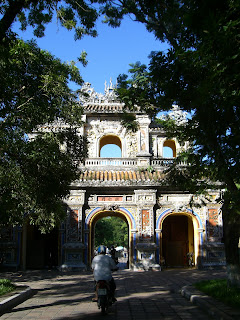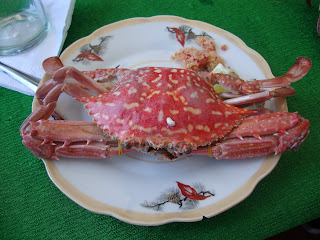
For our very last tour in Hue, we visited the Old Citadel, site of the Forbidden City of the Nguyen dynasty. The citadel walls are a street away from our hotel, but there is only one proper entrance into the palace.

Flanked by time-blackened stone walls, Hue's Forbidden City is larger than it appears. During our tour we saw a model of what the City had looked like back in the peak of the old kings. It was huge! Hue's Forbidden City is a miniature of China's more famous one. I was glad I had never visited China's Forbidden City before, so I could not compare. The Nguyen citadel to me, is sure large enough...

It's amazing to imagine that around two hundred years ago, these palace groun

ds had been bustling hubs of activity. Concubines, eunuchs, mandarins, princes, soldiers standing alert with spears, troops of musicians and dancers in swirling colors all used to populate the overgrown grounds of the Citadel. Severely damaged by bombing during the war, the Citadel is now in the process of being rebuilt by UNESCO. It's been several years since they started, and from the looks of it, they won't be finished anytime soon. We only saw a very tiny portion of the Forbidden City, but what had been restored was simply amazing and beautiful. The mosaics decorating the faces of the buildings and gates are a testament to the Vietnamese peoples' creativity: they are made out of broken pieces of ornately decorated porcelain, pieced together to form arching trees with twisting branches, songbirds with outstretched wings and dragons with sinister grinning faces.

The palace is also very colorful: the old gatehouse through which we entered into the Forbidden City is a shade of dark, fading red. Inside, restored palaces are full of scarlet columns on which gold dragons curl their serpentine bodies. A series of lone, purple columns out in a courtyard full of construction bulk tradition and laugh against a clear blue sky, towers of puffy clouds lining the horizon. Mai told me that during the Hue Festival, which occurs every two years, the Citadel is richly decorated and covered with glowing lights. I'd like to see that one day.

Some of the original buildings are still standing, and these are easy to tell apart from those newly built. Nearby a tomato red walkway on which workmen carve and paint ebony black doors, stands the old library. Its rooftop gleams with porcelain mosaics, and I glimpsed tiny figures of mandarins made out of white and blue ceramic.

As part of our tour, we dropped by the theater for a royal musical performance. Before hand, Mai and Chau saw elephants lolling around in an enclave full of tall, green grass. They looked at us and fluttered their long ears before we rushed off to catch the performance.

The theater is dark and ornately decorated. The stage is lit with dim blue lights prior to the performance, highlighting a single, gi

lded chair on which the emperor may have sat. The musicians were all beautifully dressed in royal robes of gleaming white, scarlet, and glittering gold thread. The performance consisted of three dances and one music number. Opening up the theater was a lion dance which seemed to tell the story of the courtship of two lions and the birth of their child. It was the most interesting lion dance I had ever seen, and thankfully our group was mature enough that the stranger elements only received illicit chuckles and amused smiles. Poor baby Kien was scared of the lion dancers, however, and bawled throughout the performance. I don't blame him, I myself was scared to death of lion dancers when I was a child. Next performance was a fan dance. The women were dressed in white and pink robes, and it was similar to another dance we'd seen in Hoi An, albeit on a much grander scale. Music followed, and we were all distracted by a certain male musician who looked as if he'd rather be anywhere but on the stage. It makes me feel bad when I see performers who do not appear to be enjoying what they are doing. I realize that this troupe, and others, perform numerous times a day for the beck and call of tourists. Yet, a smile here and there makes a whole difference when it comes to performing. The music was lively and pretty, but the bland faces of the musicians and dancers gave it a heavy, gloomy atmosphere. I was always relieved when I saw performers smiling. I don't know wherever to think this type of cultural display is good or not. On one hand, as a tourist and foreigner, I like to see and hear traditional Vietnamese culture. I don't think that is a bad thing at all--after all, culture can only be appreciated and real

ized when you experience it. That's why we travel, I think, to gain a greater appreciation of the beauty of the world and the uniqueness of each individual culture and people. On the other hand, I can understand where the performers are coming from. Perhaps they feel this is a type of betrayal, to flaunt themselves for people who see this type of thing as exotic. Or maybe they are just tired, the novelty and fun of the dance and music chipped away by the repetition. In any case, the musical theater, ending with a performance of dancers in bright, colorful costumes and holding lotus flower lamps, was pretty and interesting to watch. I imagined the imperial court sitting where we were, enjoying the performance: the music, the colors of the dancers' costumes. I would think it would have been much more lively, with court ladies whispering to each other behind fans, mandarins sitting stiffly, eyes riveted on the graceful forms of court dancers.

We ended our short blitz of a tiny section of the Citadel after the musical performance. This is chronically out of order, but I'd like to end this post with fish. When we first walked into the grounds of the old Citadel, we saw two deep ponds. One of them was teeming with large, golden carp. You could feed them for 2,000 dong a bag of fish food. The carp were greedy, voracious creatures. Tossing a bit of feed into the water resulted in a massive fish fight, as carp flailed their flashing gold and silver bodies, mouths round and agape, for a bit of food. It was a real sight to see.




















































